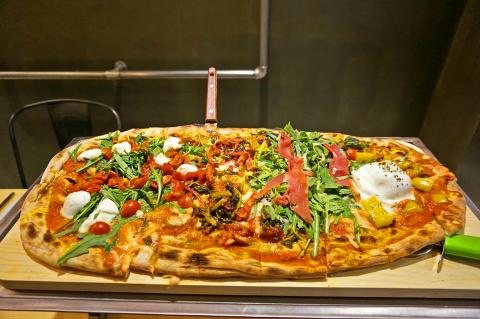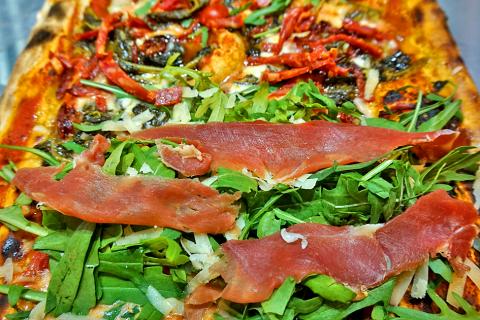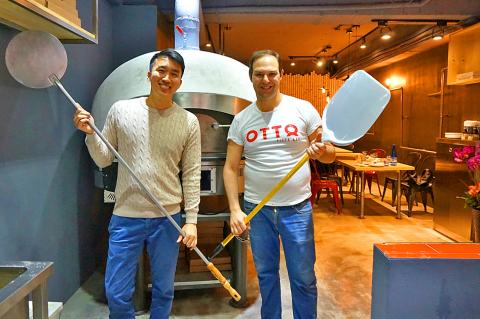The scent of burnt crust and fresh mozzarella is discernible from Zhongxiao Dunhua MRT Station (忠孝敦化捷運站). Follow it and you’ll find yourself at Otto Pizza Bar. Outside is a bright red sign and a window allowing passersby to peep into the kitchen. The interior decor threads rustic and industrial. Grayish walls are lit up by light bulbs affixed to pipes, while long wooden tables encourage family-style dining. Though they just celebrated their soft opening last month, the small and cozy pizza bar looks like it’s been a fixture of this neighborhood, with its boheme cafes and quirky clothing stores, for a while.
The centerpiece is a huge oven made of Vesuvian stone imported from Italy. The owner, Paolo Wu (吳保羅), wanted that particular style oven as it sucks the humidity from the crust, allowing it to be crispy on the outside. Such a result is not possible with small electrical ovens used by many pizzerias in Taiwan, which, according to Wu, turns the crust biscuit-like.
Otto, which means “eight” in Italian, is Wu’s lucky number. He was born in 1988 and graduated high school with 88 points (out of 90). His Italian cellphone number is 338 2888887. Raised by Taiwanese parents in Venice, Wu says he’s always had two passions: fashion and food. After working a stint in Milan’s fashion industry, he moved to Shanghai to try his hand in the food business, before opening Otto Pizza Bar in Taipei.

Photo: Dana Ter, Taipei Times
“I saw the food industry as more of a mission,” Wu tells me.
Given his background in couture, he’s had numerous people ask him why not open a fine dining Italian restaurant. But Wu was insistent on introducing to customers the type of food that Italians ate every day at home — especially, the healthy, easy-to-digest Milanese-style cuisine he was used to (so don’t expect a Hawaiian or teriyaki pizza).
Besides the vegetables which are sourced locally and delivered daily to the pizza bar (including, ironically enough, the Italian basil), the ingredients, including the flour, tomato and mozzarella, are all imported from Italy. Wu jokes that even the chef — Giuseppe “Beppe” Villani, a fourth-generation pizza maker from Naples who grew up in northern Italy — is also imported.

Photo: Dana Ter, Taipei Times
Customers have a choice between one of the eight specialty pizzas on the soft opening menu for NT$390 each. There’s also the marinara for NT$190 and the Margherita for NT$290. If sharing with a group of friends, Wu suggests the half-meter-long pizza (NT$1,200) where customers can choose among four types of specialty pizzas. The half-meter is good for four people and is served on a raised tray on the table. The purpose, Wu says, is to mimic the tradition in Italy where people stand up to reach for their pizza. It encourages more banter.
Of course, my crew and I order a half-meter-long pizza, choosing the “doc” (cherry tomatoes, arugula, fresh buffalo mozzarella), “burrata” (arugula, bell peppers, burrata), “raw” (raw Italian-style ham, arugula, freshly-grated Parmesan), and “flavor” (salami, friarielli, sun dried tomatoes) as our four specialty pizzas.
The “doc,” a classic Italian pizza, boasts simple, refined flavors and is light and easily digestible. The bits of fresh buffalo mozzarella has a smooth, milky texture that blends well with the crunchiness of the arugula and the softness and sweetness of the cherry tomatoes. It’s also a welcome taste from the chunky, packaged mozzarella used by other pizzerias. Best of all are the subtle hints of olive oil, noticeable through the layers of ingredients, and tomato sauce base, both of which make the bread not too dry nor too soggy.

Photo: Dana Ter, Taipei Times
There’s no such thing as too much cheese, and the “burrata” proves that. This pizza is best eaten fresh from the oven so that the creamy layers of burrata — a type of Italian cheese made with mozzarella and cream on the inside and a layer of mozzarella on the outer shell — can drip down the crust. The texture is creamier and runnier than the fresh buffalo mozzarella. We were given bell peppers as there weren’t enough sun dried tomatoes, but honestly, burrata tastes good with anything.
My favorites were the “raw” and the “flavor.” I highly recommend the “raw” for those with savory palates. The mild saltiness of the thinly-sliced raw Italian-style ham complements well with the peppery and pungent arugula, while the freshly grated Parmesan cheese adds a savory kick.
The “flavor,” is as its name suggests, a complex mixture of various flavors. The mildly spicy, peppery taste of the salami and the sweetness of sun dried tomatoes are a delectable pairing, though the tastiest ingredient, in my opinion, is the friarielli (more commonly known as broccoli rabe), which boasts a pungent, bitter flavor.
Wu says he used to get a little indignant by people claiming that Hawaiian pizzas and pizza topped with corn are “real” pizzas, though now he sees this as an opportunity to introduce to customers the pizza that he grew up eating in Italy. He thinks it’s going well so far. For instance, most customers were not put off by the friarelli as he thought they would be.
He’s certainly got me convinced. After dining at Otto, I’m afraid I might not enjoy the city’s other pizzerias as much. It’s the crust and the cheese that does it — especially the creamy, runny Italian mozzarella and burrata, but also the freshness of the toppings, particularly the local vegetables.
On that note, Wu is hopeful Italian pizza will become more and more popular in Taiwan.
“Authentic American food has been a wave here in Taipei,” Wu says. “I hope that authentic Italian pizza will be the next wave.”

The Directorate-General of Budget, Accounting and Statistics (DGBAS) told legislators last week that because the Chinese Nationalist Party (KMT) and Taiwan People’s Party (TPP) are continuing to block next year’s budget from passing, the nation could lose 1.5 percent of its GDP growth next year. According to the DGBAS report, officials presented to the legislature, the 2026 budget proposal includes NT$299.2 billion in funding for new projects and funding increases for various government functions. This funding only becomes available when the legislature approves it. The DGBAS estimates that every NT$10 billion in government money not spent shaves 0.05 percent off

Dec. 29 to Jan. 4 Like the Taoist Baode Temple (保德宮) featured in last week’s column, there’s little at first glance to suggest that Taipei’s Independence Presbyterian Church in Xinbeitou (自立長老會新北投教會) has Indigenous roots. One hint is a small sign on the facade reading “Ketagalan Presbyterian Mission Association” — Ketagalan being an collective term for the Pingpu (plains Indigenous) groups who once inhabited much of northern Taiwan. Inside, a display on the back wall introduces the congregation’s founder Pan Shui-tu (潘水土), a member of the Pingpu settlement of Kipatauw, and provides information about the Ketagalan and their early involvement with Christianity. Most

The People’s Republic of China (PRC) was out in force in the Taiwan Strait this week, threatening Taiwan with live-fire exercises, aircraft incursions and tedious claims to ownership. The reaction to the PRC’s blockade and decapitation strike exercises offer numerous lessons, if only we are willing to be taught. Reading the commentary on PRC behavior is like reading Bible interpretation across a range of Christian denominations: the text is recast to mean what the interpreter wants it to mean. Many PRC believers contended that the drills, obviously scheduled in advance, were aimed at the recent arms offer to Taiwan by the

Like many retirement communities, The Terraces serves as a tranquil refuge for a nucleus of older people who no longer can travel to faraway places or engage in bold adventures. But they can still be thrust back to their days of wanderlust and thrill-seeking whenever caretakers at the community in Los Gatos, California, schedule a date for residents — many of whom are in their 80s and 90s — to take turns donning virtual reality headsets. Within a matter of minutes, the headsets can transport them to Europe, immerse them in the ocean depths or send them soaring on breathtaking hang-gliding expeditions